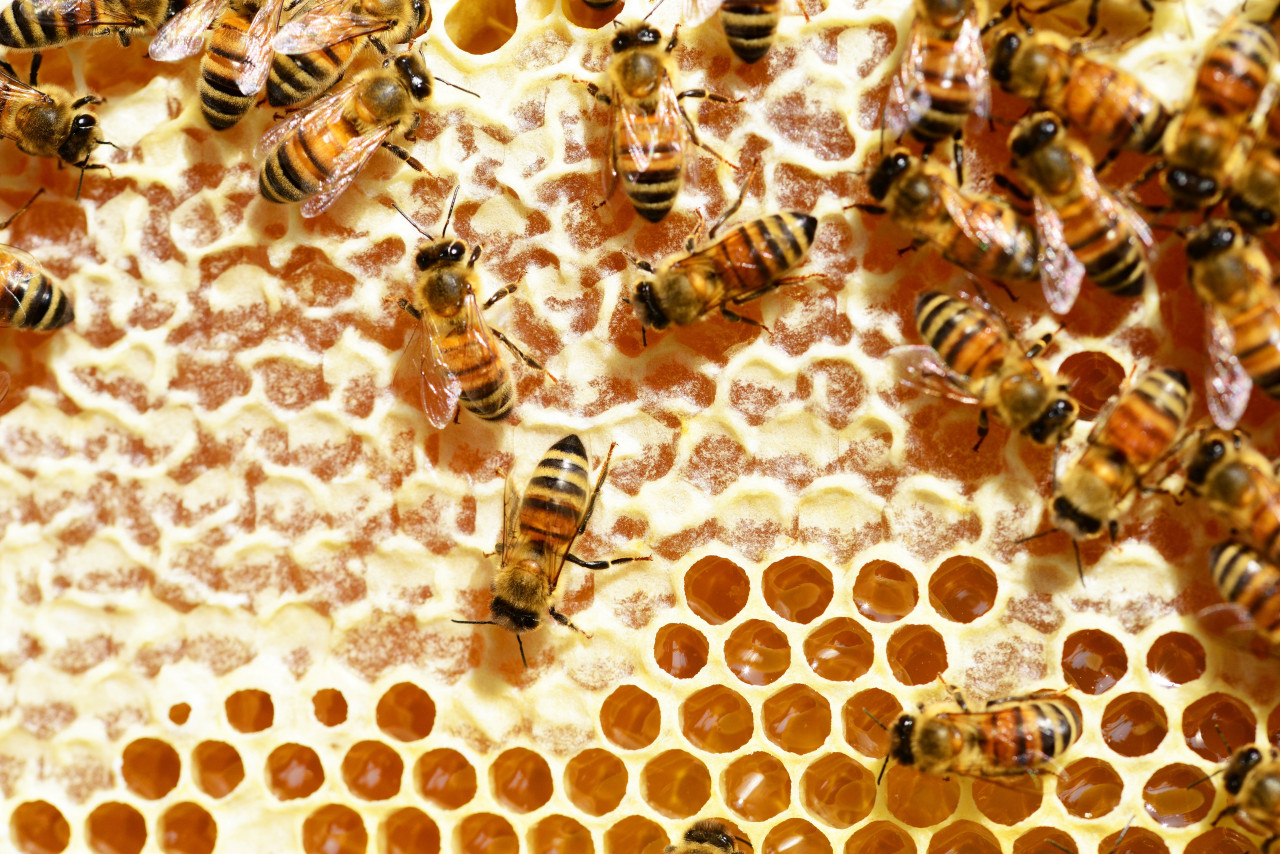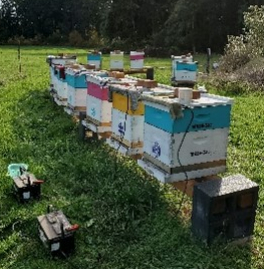The Number 1 Struggle for Beekeepers [The Varroa Mite]
How do the mites take over?
Every foundress mite that enters a cell comes out as 6-8 new mites to reinfest your bees. The numbers are overwhelming and almost insurmountable it seems, but there’s a way to get ahead of them. The big trick is to not get behind! That requires vigilance in monitoring and knocking down their numbers, or at least keeping them at a level whereby most of the bees aren’t infected with viruses or stripped of their fat body reserves. The most vulnerable time for the colony is in the fall when “drift” from collapsing colonies reinfests what you think was a mite free unit.
When is all this happening?
The new news is that the viruses have been found to be transmitted both vertically and horizontally!! The fact that the workers feed the queen and can transmit viruses through feeding is an enormous issue. Vertical transmission is when the viruses are transmitted up the chain from generation to generation. So, the queen can transmit viruses in the eggs she lays if she’s infected, but now it also means that the workers can transmit viruses up to her level by feeding her infected food.
Horizontal transmission means that the viruses can be passed from worker to worker, or worker to drone and back again through cannibalization, which is a game changer. Makes one wonder if it’s possible to eliminate viruses from the bees at all??? ….and, of course, it’s not, we live with viruses in our bodies almost all the time at various levels. Most of the time all those pathogens swirling in the air have no effect at all. The reason is the Mighty Immune System.
What’s the best way forward??
Well, that’s a good question. Since for the most part we haven’t figured out how to control the mites very well, and we certainly can’t control the viruses they’re carrying– what’s left? The amazing immune system. THAT’S the key to the issue of honeybee health IMHO and most often ignored. We put them in boxes not natural to their original habitat, we inspect them and stress them by breaking their homes open and flipping their rooms around, and we treat them with vaporized acids and chemicals that reside in their brood rearing chambers for long periods. All that said, this is livestock agriculture, and we have no options sometimes. But a little stress reduction goes a long way to improving bee health.

Viruses Kill Colonies in Winter not Mites
Who’s the Biggest Bad Guy - Mites or Viruses
Well, that’s really a good question, but since we can’t control either effectively, it doesn’t really matter, does it? A few things we know for sure from research that’s been done are that without the varroa mite creating the damage and literally sucking the life out of the bees, they would handle the viruses with a proportional amount of loss.
The mite is creating stress, and a lot of it. Without that stress and fat body damage the bees’ immune system would be able to fight the lower viral load and recover. Also, we know that some viruses are directly correlated to the level of infestation of the varroa mite. Which means the more mites, the more virus. The big picture is no matter which problem, the mite or the virus, the outcome is the same, dead colonies.
How do I monitor for mites?
Why is the Alcohol Wash an Important Test? Useful metrics is what you get with an alcohol wash. The sugar rolls are notoriously inaccurate and with so much at stake – why risk it. It’s about being able to make decisions about how to treat, when to treat, and if treatment is working. During the honey harvest season when the colonies have 3 or 4 supers on it’s even more time consuming. One helpful tip is to use the oxalic acid vaporization treatment with a screened bottom board to count varroa mite drop and assess your infestation level. About mid-summer, we see the last of the swarms and most of those are the big colonies, so those who probably have the highest mite counts. A good strategy is, if you’re going into the big colonies down to the brood box to check for queen status and brood assessments at the end of swarm season, well why not just take a sample while you’re in there after you find the queen?
During the heavy brood rearing periods you’ll see mites in the drone brood between the boxes and that’s when I start to fuss with testing.

What to do when you know you must? Treatments
There’s a ton of treatment information out there by some of the finest research institutions in the country. Know the basics. Formic Acid is about the only tool we can use during honey season. Not only is it much more expensive than oxalic acid, but we also can’t use it due to the honey on board (at least not just yet – OAV with honey supers on is coming, the label change just hasn’t happened so we must wait). So, if you must treat make sure it’s warranted. Formic is also very hard on larvae, so it’s better to treat earlier if going with the harsher treatment so that winter bee larvae aren’t affected. It’s also hard on the most fragile units – the ones with new or relatively new queens, especially the double pad protocol. You don’t want to interrupt the pheromone profiling going on during the acceptance/proofing stage of the queen in the colony, so it’s judicious to use another softer treatment for those types of units (a thymol-based treatment).
Tips, tricks, hints
The greatest asset in your journey in beekeeping training is a beekeeping mentor that gives you information based on your circumstances and has plenty of resources in images, data, and graphics that represent what you are seeing in your colonies but also what you should be seeing. It requires a team who has a vast wealth of experience and records on what they’ve seen. Know that we take the time to record everything – you could say we’re beekeeping data geeks!! Check out the membership levels and see what you think.

...So, the Number 1 problem that beekeepers struggle with is the always present Varroa Mite!! The good news is you can do something about it!!
We cover the Mighty Mite Fight in our Step 9 of the Roadmap and also in our complementary blog post dedicated to the mites and how to deal with them. So, for more information go to our The Most Important Problem....Mites blog post.
So we provide tons of resources, lots of support, and a tried and true direction for an epic beekeeping journey. Not just any journey, but a successful one where you come out the other side with confidence and measurably improved skills! This system is different – a ROADMAP with SUPPORT. Built by a seasoned educator with a lifetime of experience in managed livestock, and who’s been refined in the fire of teaching in universities and institutions across the country.
Here are some more connections for you to use to understand the benefits of the program. One is from our blog library.
The Top 4 Beekeeping Mistakes to Avoid [Better Beekeeping Blogs]
And here's a learning curve accelerator OUR 9 STEP ROADMAP TO BETTER BEEKEEPING for you to use to get better faster. If you enjoy those don’t hesitate to sign up for more (email funnel link) and hopefully we’ll see you on the inside.
#TheBeeMentor #Beekeeping Mentor #Beekeeping Coach #Beekeeping Workshops
....and as always, there's a wealth of great information on the web platform that you can access just by visiting our About Us page and learning more about the path we've got in store for you on your journey to being a BETTER BEEKEEPER - a journey of SUCCESS, SELF CONFIDENCE AND WHOLELY SUPPORTED.